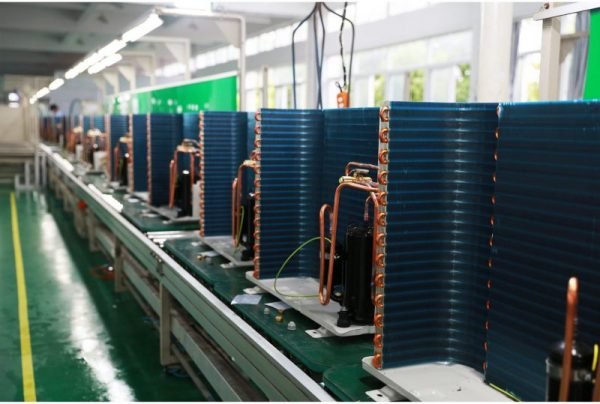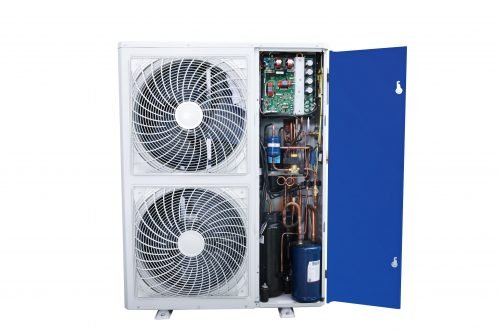Hier sind die häufig verwendeten Temperaturen für Kühlaggregate. Sie müssen sie verstehen und auf ihre Unterschiede während der täglichen Wartung achten.
Entladungstemperatur
Die Entladungstemperatur (Auch als Auspufftemperatur bekannt) der Kühleinheit bezieht sich auf die Temperatur des Kältemittels, wenn er den Kompressor verlässt. Dies ist ein kritischer Parameter in Kühlsystemen, Da spiegelt es den thermischen Zustand des Kältemittels nach Kompression wider. Die Entlademperatur liegt normalerweise im Bereich von 50° C ~ 120 ° C. (122° F ~ 248 ° F.).
Hohe Entladungstemperaturen können potenzielle Probleme wie z.:
1. Überhitzung: Kann den Kompressor beschädigen oder zu führen zu Schmiermittel Verschlechterung.
2. Falsches Kältemittel: Zu viel oder zu wenig Kältemittel kann die Systemeffizienz beeinflussen.
3. Schlechter Wärmeaustausch: Ineffiziente Wärmeabteilung in der Kondensator kann die Entlademperatur erhöhen.
4. Hoher Saug -Überhitzung: Übermäßiger Überhitzung am Kompressoreinlass kann zu hohen Entlademtemperaturen führen.
Kompressorschalentemperatur
Die Kompressorschalentemperatur bezieht sich auf die äußere Oberflächentemperatur des Gehäuses eines Kompressors während des Betriebs. Es ist ein Indikator für die Wärme, die aufgrund mechanischer Arbeit und Kältemittelkompression im Kompressor erzeugt wird.
Schlüsselfaktoren beeinflussen Kompressor Schalentemperatur
1. Kompressorlast: Höhere Lasten können zu einer erhöhten inneren Reibung und Wärme führen.
2. Umgebungstemperatur: Umgebung kann die Kühlungseffizienz des Kompressors beeinflussen.
3. Kältemittelmerkmal: Die Art und der Zustand des Kältemittels beeinflussen die thermischen Eigenschaften des Systems.
4. Systemeffizienz: Probleme wie schlechte Schmierung, verstopfte Filter, oder unzureichende Kühlung kann die Schalentemperatur erhöhen.
Normale Bereiche: Die Schalentemperatur variiert je nach Konstruktion und System, ist jedoch niedriger als die Entlademperatur. Für die meisten Systeme, Die Schalentemperatur kann zwischen dem Bereich von reichen 40° C ~ 90 ° C. (104° F ~ 194 ° F.). Es ist wichtig, innerhalb der Hersteller zu bleiben‘ Empfohlene Grenzen, um eine Überhitzung und mögliche Schäden des Kompressors zu vermeiden.
Regelmäßige Monitorschalentemperatur kann dazu beitragen, frühe Anzeichen von Ineffizienz oder Ausfall im Kühlsystem zu erkennen.
Kondensationstemperatur
Kondensationstemperatur bezieht sich auf die Temperatur, bei der die Kältemittel Änderungen von Dampf zum Flüssigkeitsstatus im Kondensator während des Kühlzyklus. Dies geschieht unter einem bestimmten Druck, Bekannt als Kondensationsdruck, Dies wird durch die Systemdesign- und Betriebsbedingungen bestimmt.
Kondensation der Bereichstemperatur
Klimaiger Kondensator
Kondensationstemperaturbedürfnisse 10° C ~ 15 ° C. (18° F ~ 27 ° F.) höher als Umgebungstemperatur.
Zum Beispiel, Wenn die Umgebungstemperatur 30 ° C beträgt (86°F), Die Kondensationstemperatur endet von 40° C ~ 45 ° C. (104° F ~ 113 ° F.).
Wasserkühler Kondensator
Kondensationstemperaturbedürfnisse 3° C ~ 8 ° C. (5° F ~ 15 ° F.) höher als Einlasswassertemperatur.
Zum Beispiel, Wenn die Kühlwassereinlasstemperatur 25 ° C beträgt (77°F), Die Kondensationstemperatur endet von 28° C ~ 33 ° C. (82° F ~ 91 ° F.).
Schlüsselpunkte zur Kondensationstemperatur
1. Beziehung zur Wärmeablehnung: Die Kondensationstemperatur spiegelt den Punkt wider, an dem Kältemittel Wärme in die Umgebung freisetzt (Luft oder Wasser) im Kondensator.
2. Systemeffizienz: Eine optimale Kondensationstemperatur ist entscheidend für die Aufrechterhaltung der Systemeffizienz. Hohe Kondensationstemperaturen können auf eine schlechte Wärmeübertragung oder eine unzureichende Kondensatorleistung hinweisen.
Kondensatorschalentemperatur
Kondensatorschalentemperatur bezieht sich auf die Oberflächentemperatur des Kondensatorgehäuses oder der Außenhülle während des Betriebs. Diese Temperatur gibt an, wie effektiv der Kondensator Wärme, das vom Kältemittel in die Umgebung absorbiert wird.
Es liegt normalerweise leicht über der Umgebungslufttemperatur, ca. 2° C ~ 15 ° C. (4° F ~ 27 ° F.) höher.
Schlüsselpunkte über Kondensatorschalentemperatur
1. Wärmeabstoßungsindikator: Die Schalentemperatur spiegelt die Wärmeübertragung in Kondensator wider. Es sollte niedriger sein als die Kondensationstemperatur des Kältemittels.
2. Einflussfaktoren:
Umgebungsbedingungen–Höhere Umgebungsluft- oder Wassertemperaturen können die Schalentemperatur in luftgekühlten oder wassergekühlten Systemen erhöhen.
Kondensatoreffizienz–Schmutz, Verschmutzung, oder schlechter Luftstrom können zu ineffizienten Wärmeübertragungen und erhöhten Schalentemperaturen führen.
Kältemitteldruck und Last–Übermäßiger Systemlast oder Kältemitteldruck kann die innere Wärme erhöhen, beeinflussen die Schalentemperatur.
Empfängertemperatur
Die Empfängertemperatur bezieht sich auf die Temperatur des in der gespeicherten Kältemittels Flüssigempfänger eines Kühlsystems. Der Flüssigkeitsempfänger ist ein Schiff nach dem Kondensator, kann die flüssige Kältemittelversorgung des Expansionsventils oder anderer nachgeschalteter Komponenten speichern und regulieren.
Schlüsselpunkte zur Empfängertemperatur
1. Beziehung zur Kondensationstemperatur
Die Empfängertemperatur liegt in der Nähe der Kondensationstemperatur, da das Kältemittel im Empfänger in einem gesättigten oder unterkühlten Flüssigkeitszustand liegt.
Es kann kaum niedriger sein als die Kondensationstemperatur, wenn die Unterkühlung auftritt, bevor das Kältemittel in den Empfänger eintritt.
2. Systembetriebsindikator
Normale Empfängertemperaturen geben den ordnungsgemäßen Systembetrieb an, mit ausreichender Wärmeentfernung im Kondensator.
Erhöhte Temperaturen könnten auf Probleme wie unzureichende Kondensatorkühlung oder hohe Umgebungsbedingungen hinweisen.
3. Temperaturbereich
Für luftgekühlte Systeme, Empfängertemperatur ist 5° C ~ 10 ° C. (9° F ~ 18 ° F.) unter Kondensationstemperatur.
Für wassergekühlte Systeme, Der Unterschied kann aufgrund einer besseren Kühlungseffizienz kleiner sein.
Filtertemperatur
Die Filtertemperatur bezieht sich auf die Temperatur des Kältemittels, wenn es durch den Filter verläuft oder Filter-Drier in einem Kühlsystem. Filter-Drier ist eine Komponente, die zum Entfernen von Feuchtigkeit verwendet wird, Schmutz, und andere Verunreinigungen aus dem Kältemittel, um das System zu schützen und einen effizienten Betrieb zu gewährleisten.
Schlüsselpunkte zur Filtertemperatur
1. Kältemittel
Kältemittel, der durch den Filter geht, befindet sich in einem flüssigen oder subkühlten Zustand auf der Hochdruckseite des Systems.
In einigen Systemen, Es kann auch Vapor-Kältemittel auf der Niederdruckseite verarbeiten.
2. Normaler Temperaturbereich
Die Filtertemperatur sollte in der Nähe der unterkühlten Flüssigkeitstemperatur des Kältemittels liegen.
Es ist 5° C ~ 10 ° C. (9° F ~ 18 ° F.) niedriger als Kondensationstemperatur.
3. Anzeichen einer abnormalen Temperatur
Der Temperaturabfall über den Filter kann eine durch Schmutz verursachte teilweise Blockierung anzeigen, Eis, oder Trümmer.
Der Temperaturanstieg könnte auf Probleme mit dem Kältemittelfluss oder einer überhitzten Komponente aufgrund von Systemeffizienzen hinweisen.
Saugentemperatur
Saugentemperatur (oder Einlasstemperatur) bezieht. Diese Temperatur ist ein kritischer Parameter für die Systemleistung und die Gesundheit des Kompressors.
Schlüsselpunkte zur Saugentemperatur
1. Verhältnis zum Kältemittelstaat
Kältemittel befindet sich in einem überdächtigen Dampfstaat, was Schaden verursachen könnte.
2. Normaler Temperaturbereich
Die Saugentemperatur ist aufgrund der Zugabe von Überhitzung kaum höher als die Verdampfertemperatur.
Typische Überhitzungswerte reichen von 5° C bis 15 ° C. (9° F bis 27 ° F.).
3. Bedeutung des Monitors
Niedrige Saugentemperatur: Zeigt unzureichende Überhitzung an, Risiko flüssiger Kältemittel in den Kompressor eindringen ( bekannt als „Flüssigschläge“).
Hohe Saugentemperatur: Schlägt übermäßige Überhitzung vor, Dies kann die Systemeffizienz reduzieren und den Kompressor überhitzen.
TXV -Temperatur
Die mit einem thermostatische Expansionsventil verbundene Temperatur (TXV) bezieht. TXV reguliert den Kältemittelfluss in den Verdampfer, basierend auf dem Überhitzung des Kältemittels und dem Verdampfer und dem Verdampfer.
Schlüsseltemperaturen in einem TXV -Betrieb
1. Sensortemperatur
Der Sensor, an der Sauglinie an der Verdampferausstellung angebracht, misst die Kältemitteltemperatur.
Diese Temperatur bestimmt den Überhitzung und kontrolliert den offenen oder nahe der Regulierung des Kältemittelsflusss des TXV.
Normalerweise 5° C ~ 15 ° C. (9° F ~ 27 ° F.) über der gesättigten Temperatur des Verdampfers.
2. Kältemittel Temperatur am TXV -Einlass
Kältemitteltemperatur, die in den TXV eindringt, ist die unterkühlte Flüssigkeitstemperatur, das sollte wenig niedriger sein als die Kondensationstemperatur.
Allgemein 5° C ~ 10 ° C. (9° F ~ 18 ° F.) unter der Kondensationstemperatur.
3. Kältemittel Temperatur im TXV -Auslass
Nach dem Durchlaufen des TXV, Die Temperatur des Kältemittels sinkt aufgrund der Ausdehnung erheblich, Erreichen der gesättigten Temperatur des Verdampfers.
Allgemein 5° C ~ 10 ° C. (9° F ~ 18 ° F.) unter der Kondensationstemperatur.
Verdunstungstemperatur
Verdunstungstemperatur (Auch als Verdampfer- oder gesättigte Temperatur bezeichnet) Bezieht sich auf die Temperatur, bei der das Kältemittel von Flüssigkeit zu Dampf im Verdampfer eines Kühlsystems wechselt.
Schlüsselpunkte zur Verdunstungstemperatur
1. Verhältnis zum Kältemittelstaat
Bei der Verdunstungstemperatur, Kältemittel absorbiert Wärme aus der Umwelt und Übergänge von Flüssigkeit zu Dampf.
2. Bestimmt durch Verdampferdruck
Die Verdampfungstemperatur entspricht der Sättigungstemperatur am angegebenen Druck innerhalb des Verdampfers. Diese Beziehung hängt von der Art des verwendeten Kältemittels ab.
Temperaturbereich
Verdunstungstemperatur ist normalerweise 5° C ~ 10 ° C. (9° F ~ 18 ° F.) unter der Zieltemperatur des abgekühlten Mediums (z.B., Luft oder Wasser).
Für Klimaanlage System, Reichweite ist 2° C ~ 10 ° C. (36° F ~ 50 ° F.).
Für niedrige Temperatur Kühlsysteme, es kann so niedrig sein wie -40° C ~ -10 ° C. (-40° F ~ 14 ° F.).
Umgebungstemperatur im Freien
Umgebungstemperatur im Freien bezieht sich auf die Temperatur außerhalb eines Gebäudes oder Kühlsystems. Es ist die externe Temperatur der Umgebung, in der das System arbeitet, und es spielt eine wichtige Rolle bei der Ausrüstungsleistung wie luftgekühlten Kondensatoren oder Outdoor-Einheiten von HVAC und Kühlsysteme.
Schlüsselpunkte zur Umgebungstemperatur im Freien
1. Auswirkungen auf die Kondensatorleistung
In luftgekühlten Systemen, Die Umgebungstemperatur im Freien beeinflusst den Kondensatoreffizienz direkt. Eine höhere Umgebungstemperatur kann die Fähigkeit des Kondensators reduzieren, Wärme abzulehnen, führen zu höheren Entladungsdrücken und Temperaturen.
2. Systemlast
Die Temperatur im Freien beeinflusst die Gesamtkühllast des Systems. Zum Beispiel, Bei heißem Wetter, Kühlanforderungen sind höher, was die Leistung von beeinflussen kann Kühlung und Klimaanlagen.
3. Saisonale Variation
Umgebungstemperatur schwankt bei den Jahreszeiten, warm im Sommer und kalt im Winter. Systeme müssen diese Variationen effektiv bewältigen.
4. Normaler Temperaturbereich
Die Temperaturbereich im Freien kann je nach geografischer Lage und Jahreszeiten stark variieren, aber normalerweise, es kann von reichen von -10°C (14°F) im Winter zu +40°C (104°F) oder höher im Sommer in vielen Regionen.
5. Bedeutung bei der Systemgröße und des Betriebs
Ingenieure berücksichtigen Umgebungstemperaturen im Freien, wenn HLK- und Kühlsysteme aus dem Entwurf ausgestattet sind, um sicherzustellen.
Abschluss
Diese Temperaturen werden von Faktoren wie Umgebungsbedingungen beeinflusst, Systemdesign, Kältemitteltyp,usw.
Richtige Auswahl und Wartung Die Temperaturen sind entscheidend für die Optimierung der Energieeffizienz, Gewährleistung der Langlebigkeit der System, und erfüllen bestimmte Kühl- oder Gefrieranforderungen.
Irgendwelche Kommentare?
Willkommen hinterlassen Sie eine Nachricht oder reposten.














